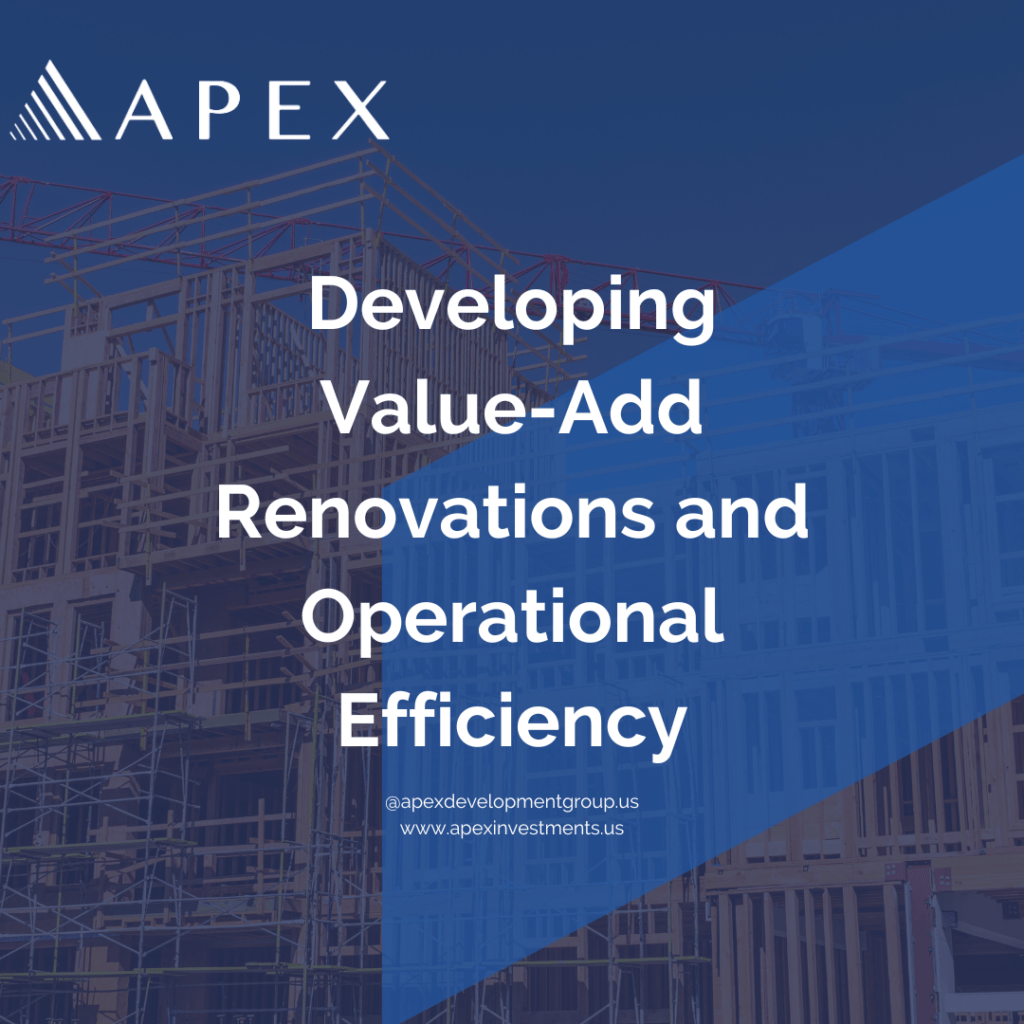
Developing Value-Add Renovations and Operational Efficiency
Renovation is a key concept in real estate investment, especially for multifamily properties. Value-Add renovations involve making strategic modifications to units to align with market expectations, within specific budget and scope limitations. Renovations do not typically include extensive structural changes, but rather careful planning of smaller, yet significant, alterations.
When delving into the process of renovation, a wide range of activities takes center stage. From the repainting of cabinets to the replacement of faucets, door handles, and appliances, every detail is carefully considered to uplift the overall look and feel of the property.
Multifamily value-add investments, powered by renovations, generate a wide range of benefits. Not only increase rental income, but also boots the overall value of their property. Moreover, a well-executed renovation can create a sense of community pride, fostering a positive environment that cultivates long-term tenant satisfaction and retention, and can also help to reduce maintenance costs and extend the lifespan of the property.
Choosing the Right Approach for Your Multifamily Property: Renovations vs Refurbishments
Understanding the difference between renovation and refurbishment is crucial. While the notion of renovation predominantly turns around transforming spaces, elevating them to their full potential, the core of refurbishment lies in substantial structural modifications, as explained before, a renovation does not include significant alterations of the unit, such us a modification of the structure that would apply to refurbishment which in other words entails significant repairs, including pivotal movements such as the displacement of walls, reconfiguration of plumbing systems, and other intricate structural alterations. From an economic perspective, the magnitude of refurbishment translates to a notably higher cost compared to renovation, consequently presenting distinctive scopes of work for each process. Therefore, a unit that undergoes renovation generally costs much less in the market, highlighting the clear difference between these two approaches in the real estate world.
This can also be seen in the investment strategies of value-add and opportunistic. While value-add method primarily focusses on strategic renovations aimed at enhancing the appeal and functionality of properties, the opportunistic approach delves into more substantial structural modifications, aligning closely with the concept of refurbishment. With value-add investments, the emphasis lies on cost-effective upgrades and targeted enhancements that elevate the overall market appeal of the property, thereby increasing its competitive edge. In contrast, opportunistic investments entail significant repairs and comprehensive structural alterations, often resulting in a higher investment cost due to the magnitude of the refurbishment process.
Multifamily Value-Add Renovations: A Strategic Approach to Maximizing ROI
Maximizing return on investment (ROI) through value-add renovations in multifamily properties requires a strategic approach that carefully considers cost-effective upgrades to enhance the property’s appeal and competitiveness in the current market. This involves understanding the target tenant demographics, identifying their preferences, and implementing improvements that tailor to their needs and aspirations.
One of the most effective ways to increase the value of a multifamily property is by renovating individual units.
In addition to unit renovations, the renovation team can also add value to a multifamily property by upgrading common areas and amenities, such as landscaping, fitness centers, pool area and outdoor living spaces. These desirable amenities can increase tenant satisfaction, leading to longer tenant retention and reduced turnover costs, which can boost investor returns.
When implementing value-add renovations, it is important to be aware of two main factors: overcapitalization and budget overruns. Overcapitalization occurs when the cost of renovations exceeds the value added to the property, which can fade away ROI and make it difficult to exit the investment profitably, in other words, spending more on renovations than the property is worth can hurt your bottom line and make it harder to walk away from the investment. On the other hand, it is important to be conscious of the cost of renovations as it might lead to budget overruns and financial strain. That is why, it is therefore important to obtain accurate estimates from qualified contractors and to factor in contingency costs.
Apex´s value-add strategy.
At Apex, our commitment lies in amplifying the value of our assets through a comprehensive approach that encompasses the revitalization of both interior and exterior spaces, striving to deliver a product that aligns seamlessly with the ever-evolving demands of the market. Moreover, our dedication extends beyond the confines of indoor spaces, as we actively enhance the communal areas, fostering an enriched living experience for our tenants. To achieve this, we have assembled a dedicated and skilled team that collaborates closely with reliable contractors to ensure the delivery of a superior-quality product. Here at Apex, we make it a priority to collaborate with experienced companies and contractors that have a strong history in this field to ensure that all the construction work runs smoothly and efficiently.
Renovations team on the field
At Apex, we understand that the success of any multifamily renovation project depends on careful planning, coordination, and execution. That’s why we have two dedicated departments responsible for carrying out all operations and logistics related to the renovation plan for each property.
The first department is responsible for everything related to supply chain and budgeting; the second department is responsible for everything related to coordination and execution of the renovation plan, product control, schedule, and budget. In general, for each project/property, we define a plan that allows us to calculate quantities and negotiate with our suppliers, seeking for efficiencies in logistics and budget. Also, we have also successfully established a subcontractor loyalty plan that ensures that our subcontractors execute our projects according to our quality and efficiency standards.
During the operation of the asset, after the acquisition, the renovation team works very closely with the Asset Management department and the property management company to be harmoniously coordinated for the correct execution of the renovation plan. Here, our role is essential to ensure that we are meeting the product standards, regulations, and defined budget as the success of the project depends on it.
At APEX, we have a strong commitment to quality and efficiency, and we are always looking for ways to improve our processes. Our success lies in the ability of our team to anticipate potential problems and address situations in a proactive rather than reactive manner. Invest in multifamily properties with a team of experienced professionals, subscribe now and learn more.
